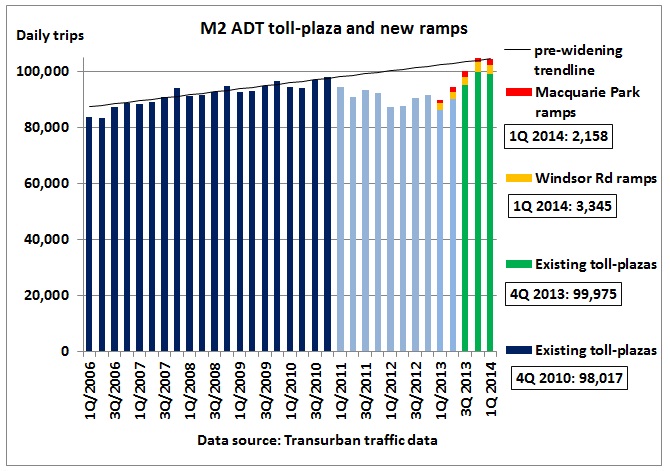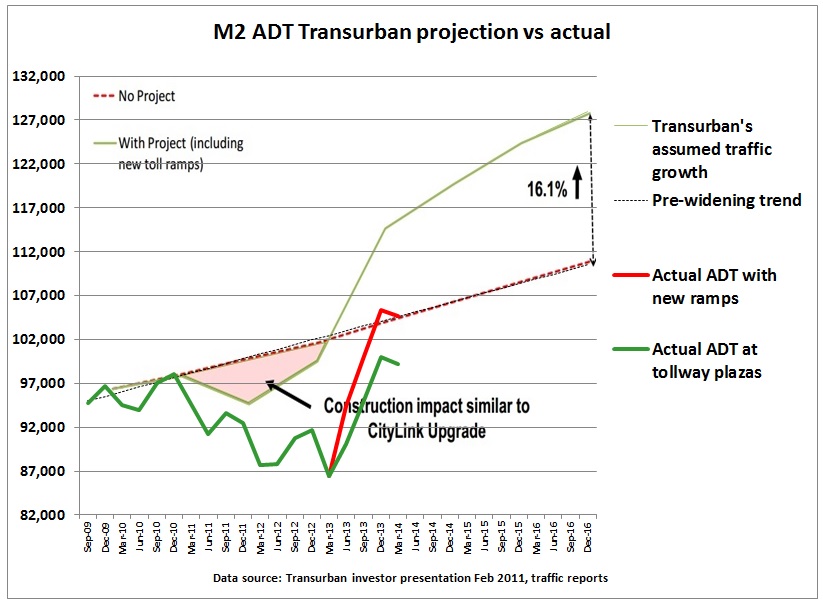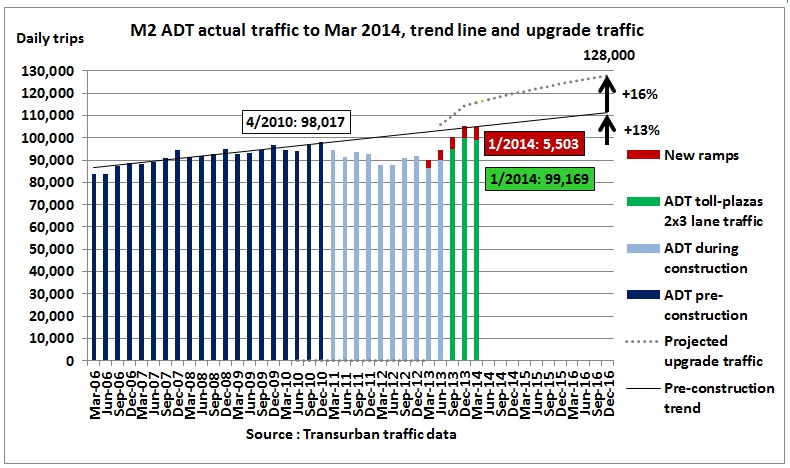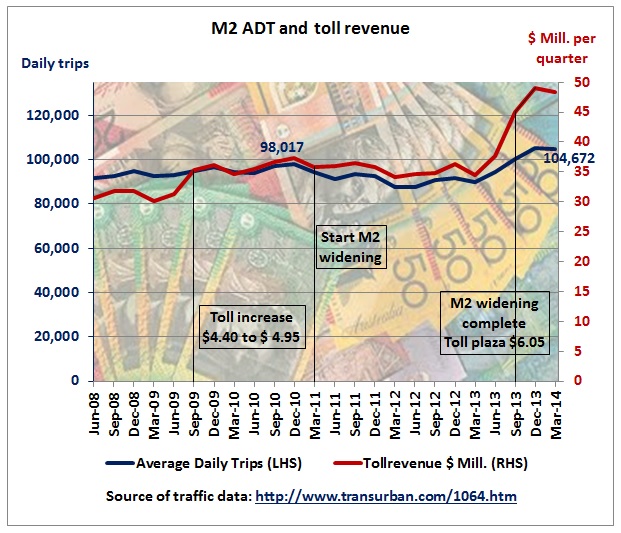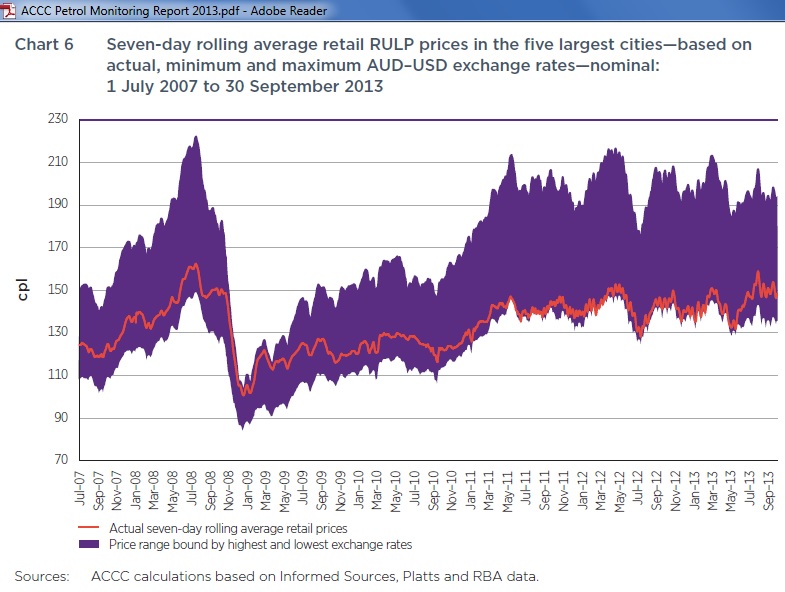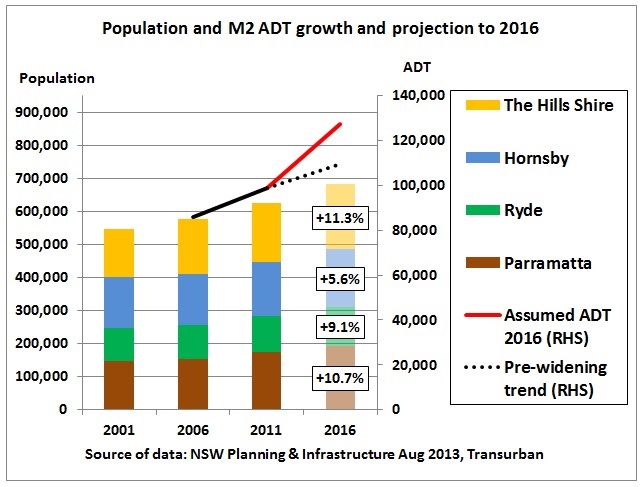In what might be an early warning sign, Transurban traffic data for the 1st quarter 2014 show that ADT on the M2 – after a 9 month ramp-up period following the opening of the 3rd lane and 2 new ramps – is just back to pre-widening trends (+ 0.5% per quarter). And this has been achieved only due to additional traffic on these new ramps. Traffic through the old plaza points at Pennant Hills Rd and Macquarie Park have grown below trend, 2% over 3 years.
Why is this important? Because this website monitors the impact of peaking crude oil production (high oil prices) on oil-vulnerable infrastructure. In Sydney’s North-West the M2 tollway was widened in 2011/13 with the expectation that traffic in 2016 would increase by 16% above pre-2011 trends. Let’s see where we are heading.
Fig 1: M2 ADT 2006 to Mar 2014
The graph shows the pre-widening trend line for traffic before construction work started (dark blue columns). Traffic then dipped as a result of these works (light blue columns). New ramps (yellow and red columns) were opened in the 1st quarter of 2013 and the 3rd lane was opened in the June 2013 quarter.
According to an investor presentation in February 2011, Transurban expected a traffic uplift of 16% by end 2016, above pre-widening trends:
Fig 2: Slide 38 in http://www.transurban.com/20110328_Investor_Presentation.pdf
Let’s put actual traffic data into this graph, keeping in mind it was “indicative” only
Fig 3: Superimposition Fig 2 and actual traffic data
We can see that traffic during construction dipped much lower and hasn’t reached the levels predicted. It could be that motorists discovered rat-race routes and have not come back.
Fig 4: M2 traffic is supposed to grow by almost 30% in 2016 compared to 2010
All in all the traffic data suggest that tolls at the Macquarie Park plaza may be too high.
Toll increases
After the widening the toll was set at $6.05 at the main toll-plaza at Macquarie Park. Since January 2014 tolls have been increased at exactly 1% per quarter or 4.06% pa.
Fig 5: Heading towards $6.80 by end 2016
This graph shows actual tolls charged (green area), a theoretical toll growing at 1% per quarter (plus a 10% GST jump in 2000 and a 7.7% increase after the widening) and the all group CPI for 8 capitals from the ABS
This exponential growth formula will lead to skyrocketing costs of using the M2, much higher than the RBA’s inflation target band of 2-3% pa
Fig 6: Toll revenue June 2008 – Mar 2014
Revenue in 1Q 2014 (commercial traffic during holidays is usually less) increased y-o-y by a whopping 2.4x more than traffic.
Petrol prices could have been higher
The above traffic data have to be seen in the context of comparatively low petrol prices. Had it not been for the high Australian Dollar, petrol prices could have gone up to $2 a litre.
Fig 7: ACCC petrol price analysis
15/12/2013 Lucky country dodged $2 a litre bullet – for now
http://crudeoilpeak.info/lucky-country-dodged-2-a-litre-bullet-for-now
Of course, no proper analysis was done on petrol prices for the M2 upgrade EIS. The words “oil” or “petrol” cannot even be found in the list of consultation issues
http://www.hillsm2upgrade.com.au/files/environmental_assessment/volume1/m2ueavol1ch5engagement.pdf
although I had made a 53 page submission in June 2010 on exactly these problems. A download can be found here:
19/6/2010 M2 widening: Primary Energy Dilemma for cars
http://crudeoilpeak.info/m2-widening-primary-energy-dilemma-for-cars
Chapter 5.5 on “Future-base Public Transport Conditions” mentions increasing oil prices
Quote from p 63
“Public Transport patronage is expected to grow in the Study Area due to:
Increasing perceived cost of private motoring as a result of increased traffic congestion and
increasing oil prices….
Given that buses are at or near capacity during peak periods, a reasonable assumption is that additional public transport will need to include increased bus services on M2…..
Increasing congestion will impact bus services as well as motorists. Without the M2 Upgrade bus travel times are expected to increase significantly along with service unreliability. Modelling indicates that by 2021 bus travel times for AM peak eastbound trips will increase by 26% and for PM peak westbound trips by 28%”
Note the twisted logic:
(a) Oil prices increasing
(b) Additional bus services needed
(c) Congestion from cars delays buses
(d) Therefore more car lanes needed
Traffic growth exceeds population growth
Population estimates published by the NSW government in August 2013 show population growth of 9.3% between 2011 and 2016 in 4 LGAs in the catchment of the M2:
Fig 8: M2 traffic growth (actual and assumed) vs population growth
Average population growth in 4 LGAs around the M2 between 2011 and 2016 is assumed to be 9.3%. Data are from: http://www.planning.nsw.gov.au/en-au/deliveringhomes/populationandhousingprojections.aspx
Compare that growth with a planned traffic growth of around 30% or 3 times higher than population growth. Therefore, there is no statistical evidence to support the following statement on the benefits of the M2 Upgrade, published by the Roads and Maritime Services in Sep 2013
“The project aims to provide efficient and integrated transport for the community of Sydney’s North-West.”
In fact, Transurban’s real objective can be found in the EIS Chapter 7.2.6.4 (p 79)
“….and confirms the objective of the Project to encourage longer distance travel along the motorway network.”
Fig 9: Graph from 2013 NSW preliminary population projections, p8
65% of population growth in NSW is driven by an ambitious net overseas migration program. The higher the rate of NOM, the longer the lines at the filling stations when crunch time arrives.
Summary:
M2 traffic growth appears to be soft compared to 2011 expectations despite a benign petrol price context as a result of both the high Australian dollar and global oil prices being kept in check by US shale oil growth. So Transurban was undeservedly lucky because none of these factors were analysed in the business case or the EIS. Nor are they taken into account for the next project nearby, NorthConnex. When these fuel price factors change, e.g. when US shale oil peaks before 2020 or when the AUD exchange rate goes down, there will be some surprises. Irrespective of their oil vulnerability these toll-ways suffer from following inherent structural problems:
- Toll costs to the community are increasing more than traffic itself
- The toll-inflator of 1% per quarter laid down in the original Private Public Partnership deed is much higher than the RBA’s inflation target of 2-3% pa.
- Assumed traffic growth necessary to pay for building and operating tollways (including interest payments and distributions to shareholders) is outpacing population growth.
These undesirable trends cannot continue indefinitely without financial consequences. So we have several indicators of inefficiency. Toll-ways cannot increase Sydney’s productivity.
Recent related post
27/3/2014
Australian governments want to pay $810m subsidy for unviable road tunnel in Sydney as next oil price spike looms (part 1)
http://crudeoilpeak.info/australian-governments-want-to-pay-810m-subsidy-for-unviable-road-tunnel-in-sydney-as-next-oil-price-spike-looms-part-1
